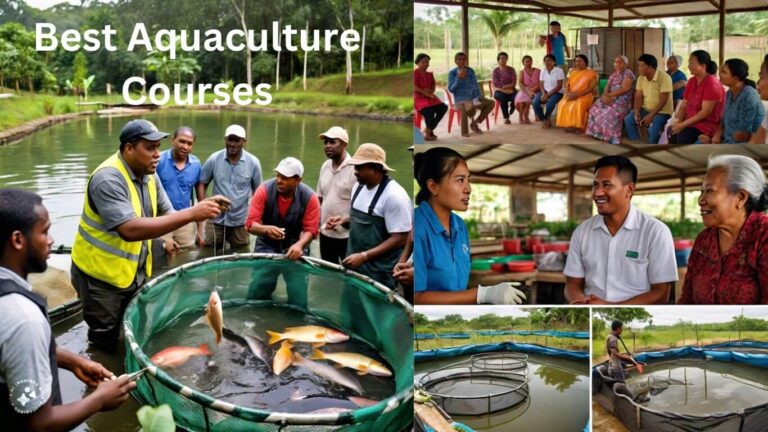Problems in fish farming are the practices of fish farmers which pose a threat to either humans, the environment, the ecology, or the fish themselves.
Fish farming, as part of aquaculture, has become increasingly important as a means of meeting the growing demand for seafood worldwide.
While it offers solutions to overfishing and food security, it comes with its own set of challenges. In this blog post, we explored the various problems associated with fish farming, including stocking density, parasites and disease, ecosystem impacts, siting, genetic modification, labeling, and inhumane slaughter methods. So keep reading to the end.
1. Stocking Density
Stocking density refers to the number of fish stocked per unit of water in aquaculture systems. High stocking densities can lead to overcrowding, which in turn can result in competition for resources such as food, oxygen, and space. This also increases stress levels and higher susceptibility to diseases.
When fish are crowded together, they produce more waste, which can lead to poor water quality and increased risk of pollution.
Additionally, high stocking densities may require the use of antibiotics and other chemicals to prevent the outbreak of diseases, further impacting the environment and potentially leading to the development of antibiotic-resistant bacteria.

Highly Density stocked fish
2. Parasites and Disease
Parasites and diseases are major concerns in fish farming. Crowded conditions and high stocking densities create favorable environments for the spread of pathogens.
Common diseases include bacterial infections, viral diseases, and parasitic infestations such as sea lice.
The use of antibiotics and other medications to control diseases can have negative consequences for both the environment and human health. Residues from these drugs can accumulate in the water and seafood, potentially leading to antibiotic resistance in bacteria and harmful effects on consumers.
3. Ecosystem Impacts
One of the problems in fish farming is the impact on surrounding ecosystems. Waste from fish farms, including uneaten feed, feces, and chemicals, can pollute waterways and harm native aquatic species.
Escapes of farmed fish can also introduce non-native species into natural habitats, leading to competition with native species and genetic dilution of wild populations.
Furthermore, the extraction of wild fish for use as feed in aquaculture operations contributes to overfishing and disrupts marine food chains.
This practice can have cascading effects on marine ecosystems and biodiversity.
4. Siting
The location of fish farms is crucial to their environmental impact. Poorly sited farms can increase pollution and disease transmission, particularly in sensitive coastal areas.
Farms located in areas with strong currents or tidal flows may disperse waste more effectively, reducing the risk of pollution.
However, even well-sited farms can still have negative impacts on local ecosystems and communities.
Noise pollution from farm operations, disruption of natural habitats, and conflicts with other users of coastal areas are all potential concerns.
5. Genetic Modification
Genetic modification is increasingly used in aquaculture to enhance traits such as growth rate, disease resistance, and tolerance to environmental stressors.
While genetic modification can offer benefits such as increased productivity and reduced reliance on antibiotics, it also raises ethical and environmental concerns.
Genetically modified fish may escape from farms and interbreed with wild populations, potentially altering the genetic diversity and ecological balance of native species.
Furthermore, the long-term effects of consuming genetically modified seafood on human health are still not fully understood. That is classified as one of the Problems in fish farming
6. Labeling
Labeling of farmed seafood is often inadequate, making it difficult for consumers to make informed choices about the products they purchase.
Without clear labeling indicating the origin, production methods, and environmental impact of farmed fish, consumers may inadvertently support unsustainable or environmentally harmful aquaculture practices. Sometimes as part of the Problems in fish farming, mislabelling of fish farm produce can lead to food fraud. Food fraud occurs when a farmer or marker of farm produce intentionally miscommunicates about the produce to the consumer or buyer. This may intend to make sales, profit, or other reasons.
Improved labeling standards and certification schemes can help consumers identify responsibly farmed seafood and support more sustainable aquaculture operations.
7. Inhumane Slaughter Methods
The slaughter of farmed fish is another ethical concern associated with fish farming. Traditional slaughter methods, such as asphyxiation or live chilling, can cause unnecessary suffering to fish.
More humane slaughter methods, such as electrical stunning or percussive stunning followed by immediate bleeding, are available but may not be widely implemented due to cost or logistical constraints.
Some also use salt in the killing of fish. The fish are harvested into a container without water and salt is added to them. The salt burns them till death.
Solutions To The Problems In Fish Farming
“No matter how long a walking stick is, it always has its handle”. Big problems come with big solutions. Every problem has gotten its solution. Below are some of my proposed solutions to the problems in fish farming as enumerated.
1. Stocking Density
– Conduct regular monitoring of stocking densities to ensure they remain within recommended limits for each species and life stage.
– Implement stocking density guidelines specific to each aquaculture system, considering factors such as water flow, oxygen levels, and waste removal capacity.
– Utilize advanced technologies such as automated feeders and sensors to optimize feeding practices and minimize competition for food.
– Promote selective breeding programs aimed at producing strains of fish that exhibit better tolerance to high stocking densities and stress.
– always sort your fish to separate them based on size. This also helps in reducing high stock density therefore reducing the problems in fish farming
– Educate fish farmers on the importance of maintaining appropriate stocking densities and the potential consequences of overcrowding.
2. Parasites and Disease
– Develop and implement comprehensive biosecurity protocols, including strict quarantine measures for incoming stock and regular health screenings.
– Invest in research to develop vaccines and alternative disease control methods, such as probiotics, prebiotics, and herbal remedies.
– Encourage the use of integrated pest management techniques to control parasites, including biological controls and environmental manipulation.
– Promote responsible antibiotic use through the development of antibiotic stewardship programs and the use of alternative treatments where feasible.
– Provide training and support for fish farmers in disease prevention and management practices, including proper sanitation and hygiene procedures.
3. Ecosystem Impacts
– Conduct thorough environmental impact assessments before establishing new fish farms to identify potential risks to surrounding ecosystems.
– Implement best management practices to minimize nutrient runoff, sedimentation, and other forms of pollution from aquaculture operations.
– Invest in research and development of Recirculating Aquaculture System (RAS), reducing the need for external inputs and minimizing discharge.
– Promote the restoration and conservation of coastal habitats to mitigate the impacts of fish farming on biodiversity and ecosystem health.
– Encourage collaboration between fish farmers, government agencies, and environmental organizations to develop and implement sustainable aquaculture practices.
4. Siting
– Establish siting criteria based on environmental, social, and economic factors to guide the location of new fish farms.
– Involve local communities and stakeholders in the siting process to address concerns and ensure that proposed sites are acceptable to all parties.
– Conduct thorough site assessments, including studies of water quality, currents, and habitat suitability, to identify suitable locations for fish farming.
– Consider the potential cumulative impacts of multiple aquaculture operations in a given area when setting up new farms.
– Develop adaptive management plans to monitor and mitigate any unforeseen impacts of fish farming on the surrounding environment.
5. Genetic Modification
– Establish clear regulatory frameworks for the approval and labeling of genetically modified seafood products to ensure consumer choice and safety.
– Invest in research on non-GMO breeding techniques, such as marker-assisted selection and gene editing, to improve desirable traits in farmed fish.
– Promote transparency and public engagement in discussions about the use of genetic modification in aquaculture.
– Encourage collaboration between researchers, industry stakeholders, and regulatory agencies to assess the potential risks and benefits of genetic modification in fish farming.
– Support the development of sustainable and ethical breeding programs that prioritize animal welfare and environmental sustainability.
All these can help mitigate the problems in fish farming.
6. Labeling
– Advocate for standardized labeling requirements that provide consumers with clear and accurate information about the origin, production methods, and environmental impact of farmed seafood.
– Promote certification schemes such as the Aquaculture Stewardship Council (ASC) and the Marine Stewardship Council (MSC). This is to help consumers identify responsibly farmed seafood products.
– Encourage retailers and food service providers to prioritize sourcing from certified and sustainable aquaculture operations and to provide transparent labeling to customers.
– Educate consumers about the importance of making informed choices when purchasing seafood and how to interpret labeling information effectively.
– Work with governments and industry stakeholders to enforce labeling regulations and ensure compliance across the aquaculture supply chain.
7. Inhumane Slaughter Methods
– Provide training and resources for fish farmers on humane slaughter techniques. These include methods such as electrical stunning or percussive stunning followed by immediate bleeding.
– Develop and implement industry-wide standards for humane slaughter, including requirements for facilities, equipment, and staff training.
– Conduct regular audits and inspections of fish processing facilities to ensure compliance with humane slaughter standards and identify areas for improvement.
– Promote research into alternative slaughter methods that minimize stress and pain for farmed fish, such as immersion in carbon dioxide or inert gases.
– Raise awareness among consumers and retailers about the importance of supporting humane aquaculture practices and choosing products that meet high welfare standards.
8. Law Enforcement
Both National and International bodies should ensure that there are adequate rules and regulations governing the practices of fish farmers.
The already existing laws should be reinforced to ensure compliance. New laws can also be formulated. All these will help mitigate the problems in fish farming.
The farmers who disobey those laws should be brought to book. Humans are sometimes hard by nature and need hardness to set certain things right. I have constantly mentioned education and training above as solutions. But there are some individuals, just education cannot guide them unless the hard way.
At the end of the day, if the problems in fish farming are solved, is going to be enjoyable for everyone and not just one person.
Conclusion
Fish farming offers solutions to many challenges facing the seafood industry, but it also poses various problems in fish farming. Significant among them are environmental, ethical, and health risks.
Addressing these problems requires careful management of stocking density, disease control, ecosystem impacts, siting practices, genetic modification, labeling, and slaughter methods.
By adopting sustainable practices and promoting transparency in the industry, we can work towards a more responsible and ethical approach to aquaculture.
By implementing these detailed solutions, stakeholders in the aquaculture industry can work towards mitigating the various problems in fish farming.
This can also promote a more sustainable and ethical approach to seafood production.
Recommendation
Despite fish not being human, there is both logical and scientific proof that they also have feelings and emotions and therefore feel pain.
Based on the fact that fish can suffer, the way they are currently treated is a major issue of moral concern. Right now, tens of billions of fish are held captive in industrial farms around the world.
I, therefore, recommend that the proposed solutions above should be implemented by fish farmers, stakeholders, the government, and the general public to ensure that the problems in fish farming are drastically reduced.
I also recommend that you should speak to an aquaculture expert to guide you in your fish farming venture. Check out this post on the Best 8 Aquaculture Experts.





